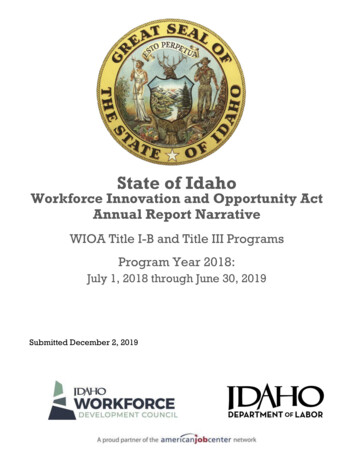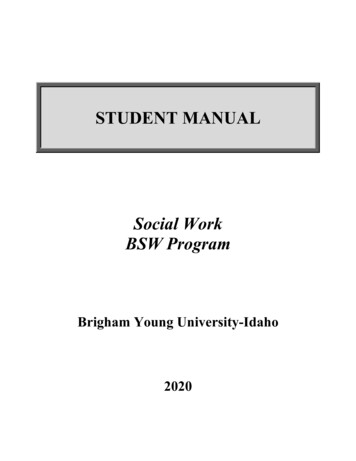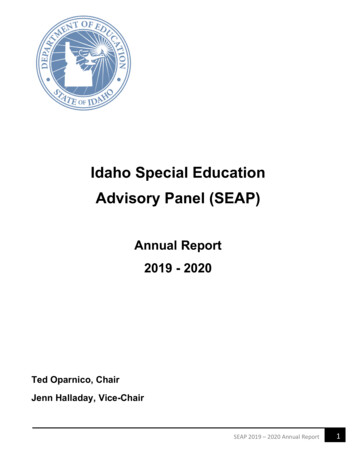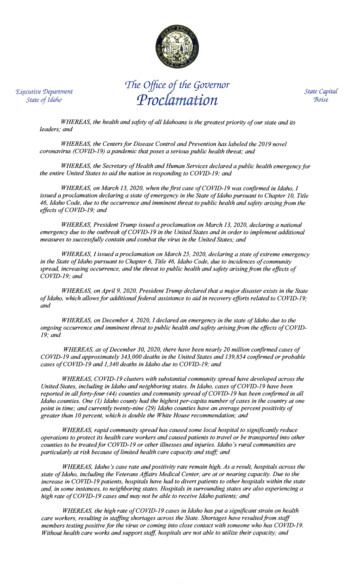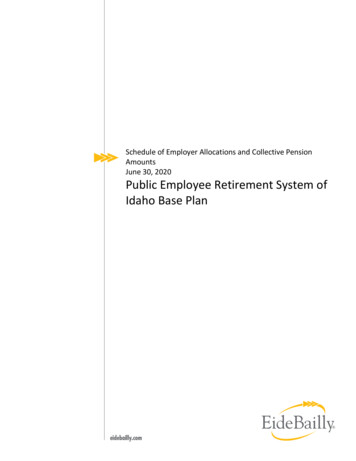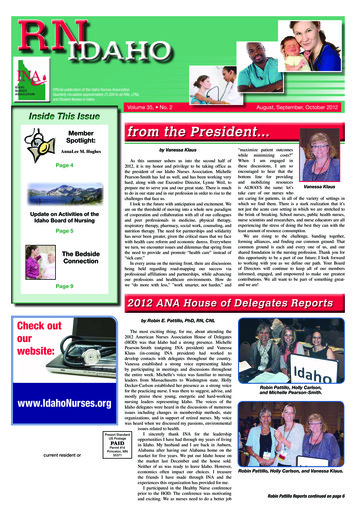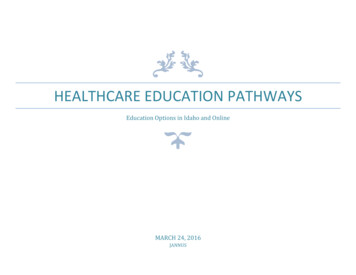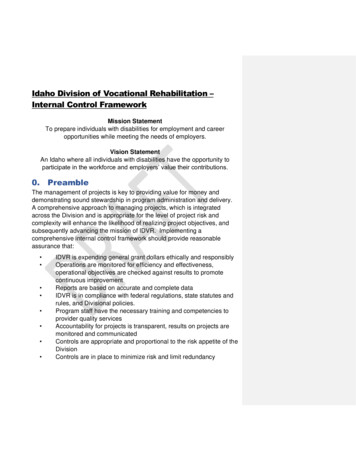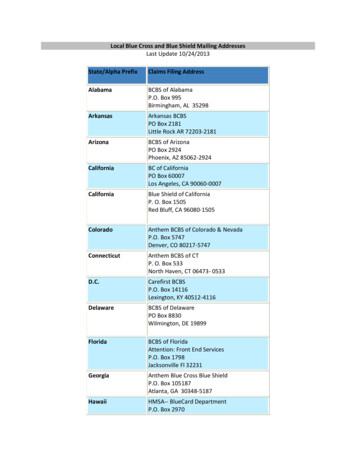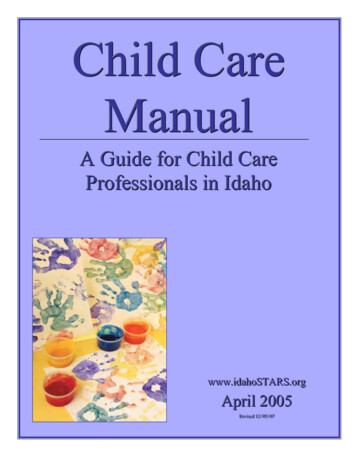
Transcription
Child CareManualA Guide for Child CareProfessionals in Idahowwwwww.iiddaahhooSSTTAARRSS.oorrggApril 00777
Table of ContentsTable of Contents .1Table of Contents .2Introduction .1Child Care Guidelines .2Day Care Licensure .8Playing Safe in the Sun .11Outdoor Safety Checklist Recommendations .12Guidelines for Toy Safety .13Child Care Consultations .15Plants That Poison .16Pictures of Plants That Poison .18Guidelines for Food Preparation and Handling .20Dental Emergencies .22Changing Diapers .24Components of a Diapering Area .25Disinfection Procedures .26Bleach Solutions .28Hand Washing Steps .30How Diseases Are Spread .32Infection Control Measures .33Symptoms of Illness .37When a Child Has Symptoms .37Rash Flow Chart .38Features of Rash Illness .39Idaho Reportable Diseases List .42When to Notify Parents and Contact the Health Department about an Infectious Disease .43When to notify Parents if the illness is in the school/daycare .44Amebiasis .45Chickenpox (Varicella) .47Informational Letter for Parents Chickenpox .49Conjunctivitis (Pink Eye) .50(Pink Eye) .50Informational Letter for Parents Conjunctivitis (Pink Eye) .51Cryptosporidiosis (Cryptosporidium parvum) .52Cytomegalovirus Infections (CMV) .54Informational Letter for Parents Cytomegalovirus Infections (CMV) .55Diarrheal Diseases .56E. coli O157:H7/Shiga Toxin producing E.Coli .57Fifth Disease .58Informational Letter for Parents Fifth Disease.59Haemophilus influenzae Meningitis .60Giardiasis .61Hand, Foot, & Mouth Disease (Coxsackie Virus Infection) .62Head Lice Advice and the Licemeister Comb .66Informational Letter for Parents Head Lice .67Hepatitis A .68Hepatitis B.70
Herpes Simplex .71Information Letter for Parents Herpes Simplex .73Human Immunodeficiency Virus (HIV/AIDS) .74Impetigo .76Informational Letter for Parents Impetigo .77Influenza.78Informational Letter for Parents Influenza .79Measles (Rubeola) .80Meningitis (Hib) (Haemophilus Influenzae Type B) .82communicable disease. Also, see Meningitis Meningococcal Disease.82Meningitis Meningococcal Disease .83Informational letter for Parents Mononucleosis .85Mumps (Parotitis) .86Norovirus .87Pinworms (Enterobiasis) .88Informational Letter for Parents Pinworms.89Respiratory Syncytial Virus (RSV) .90Ringworm .92Informational Letter for Parents Ringworm .93Roseola .94Information Letter for Parents Roseola .95Rubella (German Measles) .96Salmonellosis .98Scabies.99Informational Letter for Parents Scabies.100Shigella (Shigellosis) .101Staphylococcal Infections .102Informational Letter to Parents Staphylococcal Infections .103Strep Throat & Scarlet Fever .104Informational Letter for Parents Streptococcal (Strep) Infections .105Thrush/Yeast Diaper Rash .106.107Informational Letter for Parents Thrush/Yeast Diaper Rash .108Tuberculosis (Pulmonary) .109Whooping Cough (Pertussis) .110Immunizations Idaho Code, Chapter 11, Section 39-1118: .111Immunization Schedule.112Immunization Requirements .116Licensed Day Care Facility Immunization Requirement Certificate of Exemption .120Idaho’s Immunization Registry System - A Note for Parents .121Pets .122Recommendations for Preventing the Transmission of Salmonella from Reptiles to Humans .124Hobo Spider Bites .125Complaints .126Fire Safety Standards for Child Care .127Reference: IDAPA 18.01.55 .127Idaho Code Title 39 Chapter 11 Basic Day Care License .130Some Helpful Websites .140Glossary .141
IntroductionThis manual has been developed by the staff at the public health district as a reference tool for manydifferent situations and covers basic information needed to operate a childcare operation in a manner thatwill protect the health and safety of the children being cared for and help control illnesses within thechildcare facility.Being chosen to care for a family’s children is a big responsibility for any childcare facility, from thesmallest of family home settings to the largest childcare centers in the area. The public health districtsconduct health and safety inspections for all childcare facilities in Idaho. The Department of Health andWelfare, some cities, and the Idaho Child Care Program require health and safety inspections as part ofthe licensing/registration process. The role of the health district is an outreach and educational approachto obtain childcare provider compliance with t he health and safety regulations governing the childcareprograms.Topics such as food safety; communicable disease guidelines; immunization requirements and recordreviews; poison prevention and toxic storage; hand-washing; diaper changing procedures; hygienicpractices; sanitizer usage and formulation; fire code requirements; play/nap areas; first aid/CPRrequirements; child-staff ratios; and some diseases are all covered in this handbook.Complaint inspections/investigations are also conducted by the health district and may be done by anyone of the health district’s Environmental Health Specialist/Nurses.If you have received this manual, you more than likely received it during a visit from the DistrictsChildcare Inspection Program staff.-1-
Child Care GuidelinesAge & Health of ProviderProvider must be 18 years old or older. Persons 16 or 17 may provide care if directly supervised by aprovider. A caregiver must not work when ill as per Rules and Regulations Governing Idaho ReportableDiseases.CPR/First Aid TrainingMust have at least ONE adult on premises at all times who has a current certification in pediatric rescuebreathing and first aid treatment from a certified instructor.Staff/Children Excluded When IllProvide a written procedure that outlines what will be done if a child becomes ill while in your care. Thisprocedure must address:a. Keeping the child separated from the rest of the children to prevent spreading disease.b. The care provided for the child.c. Notification of parent or guardian.A caregiver must not work when ill as per Rules and Regulations Governing Idaho Reportable Diseases.Immunization RecordsIdaho Code 39-1118 requires that each child’s immunization record or reason for exemption is providedto the operator within fourteen (14) days of initial attendance. Provide information about immunizationsto parents if asked.Emergency CommunicationA functional telephone is required.Smoke Detectors, Fire Extinguishers, and Fire ExitsAdequate smoke alarms, functional telephone, fire extinguishers and exits are required. Centers, Group,and Family Day Cares must be certified by the Fire Marshal.Fire Extinguisher – A minimum of one fire extinguisher (type 2-A:10-BC) or (3-A:10-BC) forin-home child care.Smoke Detector – One for each sleeping area, hall-way, and on each floor level. Each onemust have a test button. It is recommended that one should be wired to an electrical current.Emergency Exits – Adequate emergency exits are determined by the local Fire Marshal.Centers must meet staff-child ratios:1:6 for less than 18 months old.1:12 for 18 months to 5 years old.1:18 for over 5 years old.Food Source/Food ThawingPasteurized milk only.No home canned foods, except jams or jellies.No wild game, USDA approved meat only.-2-
Do not thaw foods at room temperature.Thawing Options:In refrigerator (best option).In cold running water.As part of cooking process.In microwave, then immediately complete cooking.Food Handling/Personal HygieneFood preparation includes cooking meat to proper temperatures, avoiding cross-contamination,minimizing bare hand contact, proper hand washing.Clean clothes or apron during food prep, no smoking.Unwrapped foods may not be re-served once plate is on the table.Minimize direct hand contact with food.Use serving utensils or gloves whenever possible to prevent hand contact with ready to eatfoods.Wash Hands Often:Before touching or preparing foodAfter wiping noseAfter coughing into your handAfter smokingAfter changing each diaperAfter using the toiletFood Contact Surfaces/SanitizingFood contact surfaces must be kept clean (counters, tables, high chairs, cutting boards) and sanitized witha solution of chlorine 50-200 ppm or quaternary ammonium chloride 200 ppm. Obtain test strips todetermine correct concentration.SANITIZING SOLUTION MIXTURE: Mix: 1 tablespoon bleach in each gallon of warm water. Useunscented liquid bleach, such as Clorox, Purex, etc. Note: Mix 3/4 teaspoon to 1 quart of water.OTHER SANITIZING CHEMICALS: Allowed ONLY if the label states it is suitable for dishes andlabel directions are given.Cutting boards, knives, counters, pots and pans, plates, cups, forks, and spoons must be clean andsanitized, in good repair, smooth, easy to clean.Refrigerators, cabinet shelves, sinks, dish machines, utensil handles, must be clean, in good repair,smooth and easy to clean.Wiping cloths, dish cloths used for tables, counters, high chairs, etc. are rinsed in a sanitizing solutionbefore and after use.An option is to use a spray bottle of sanitizing solution to wet the wiped object.Spray Bottles: Two (2) recommended: One for the kitchen and one for the bathroom/diaper changingareas. Label the bottles as to contents and intended area of use.-3-
Renew bleach spray bottle contents weekly. More information is on page 28.Dishwashing/SanitizingDishes, glasses, utensils and silverware shall be washed either in a dishwasher with a sanitizing dry cycle,or by the four-step method.A. Use one of the Health District approved dishwashing methods.It is best if a separate sink or basin is used for each step #2, #3, #4.1.Rinse or scrape food off the item to be washed.2.Wash the item in hot soapy water.3.Rinse the soap off with clear hot water.4.Sanitize the item by soaking in a solution of regular unscented liquid bleach and warmwater. Soak at least 10 seconds. See Food Contact Surfaces/Sanitizing (above).5.Air dry the item on a drain rack.B. An automatic dish machine may be used.6.A home-style dishwasher that has a heat drying or sani-cycle is acceptable. The itemsmust be run through the complete washing cycle.7.Larger child care facilities should consider a commercial dishwasher with a sanitizingrinse. These units have a much faster cycle allowing dishes to be reused in minutes.Utensil StorageProtect clean utensils, glasses, dishes, pots and pans, from contamination.Do not store under sinks or on the floor. Utensil trays and cabinets must be clean. Face utensil/handles inone direction.Drawers holding sharp utensils (knives) should be secured with child-proof latches.Food Temperatures/ThermometersRefrigerator must be equipped with an accurate thermometer, metal or plastic shielded. Refrigeratorcolder than 41 F (38-40 F preferred).Foods must cool rapidly (within 4 hours) to below 41 F.Eggs must be refrigerated.Perishable cold foods must be stored at 41 F or less.Hot food must be cooked (or reheated) to 165 F before serving.After cooking, hot foods must be kept at 135 F.Food Storage/Cross ContaminationCooked foods are stored above raw foods.Keep food stored off the floor and protected from dust, flies, pets, water, and chemicals. Do not storeunder plumbing pipes.Food stored in refrigerators has to be covered to prevent cross-contamination. See FoodTemperatures/Thermometers.Medicines/Hazardous Substances-4-
STORE ALL CHEMICALS AND MEDICINES –OUT OF REACH OF CHILDREN – OR IN ALOCKED CABINET.C. CHEMICAL/TOXIC/POISONS STORAGEBleach, cleaners, disinfectants, plant fertilizers, insect sprays, paint thinners, or otherchemicals must be stored away from foods and utensils.D. MEDICINE STORAGE1. Store medicines out of reach of children.2. Refrigerated medicines: Place in a container with a lid or in a Ziploc bag. Mark containerMEDICINES.3. Medicines and vitamins in the kitchen must be in a container marked MEDICINES.Cleaning materials, detergents, aerosol cans, pesticides, health and beauty aids, poisons, and other toxicmaterials shall be stored in their original labeled containers and shall be used according to themanufacturer’s instructions and for the intended purpose. They shall be used only in a manner that willnot constitute a hazard to the children. When not in actual use, such materials shall be kept in a placeinaccessible to children and separate from stored medications and food.All arts and crafts materials used in the facility shall be non-toxic. There shall be no eating or drinking bychildren or staff during use of such materials. Poisonous or potentially harmful plants on the premisesshall be inaccessible to children.Garbage Covered/RemovedGarbage and disposable diapers must be in covered containers or closed garbage bags. They should betaken to outside container daily for weekly removal. Use plastic liners in all trash receptacles.Garbage/trash needs to be stored where it is inaccessible to children and cannot attract vermin.Plumbing/Sewage DisposalWater supply pipes, faucets, or hoses below a sink rim, or in a drain or sewer may create a crossconnection between drinking water and dirty water.A. The toilet ballcock (water flow control valve) must be one inch above the overflow pipe in thetoilet tank.B. Proper backflow prevention must be present for things such as:1. A hose attached to a sink faucet.2. A hose filling a wading pool.3. An underground landscape/lawn sprinkler system.4. A water softener drain line.Plumbing must be in good condition and comply with local plumbing code.The dishwasher drain hose must be fastened to touch the underside of the counter top. A dishwasher airgap device is preferred (required in commercial centers) to prevent backflow of sewage in the dishwasher.Sewage must be properly disposed with no overflows or surfacing to cause food contamination.Water Supply/Well SampleThe water must be from a Health District approved source and be free of contamination.PRIVATE WELLS: CONTACT HEALTH DISTRICT-5-
Our office will collect a sample of the water and inspect the visible portion of the well. Thereafter if thereare more than 24 persons in the facility it is your responsibility to submit quarterly water samples to aprivate laboratory. If there are less than 24 persons in the facility then it must be a yearly sample.A copy of each lab report will be sent to the Health District.Hand Washing FacilitiesA hand sink needs to be close to the diaper changing area.A separate kitchen hand sink may be required in larger child care facilities for hand washingprior to preparing foods.The kitchen sink is not to be used for hand washing after changing diapers.A hand sink must be provided where care givers and children can wash their hands after usingthe restroom, before eating, and at other times as needed.The sink(s) used for hand washing must have hot and cold running water through a mixingfaucet. Soap and paper towels must be present. (Soft or liquid soap is recommended in lieu ofbar soap).Diaper ChangingThe changing area cannot be in the kitchen or on counters or tables used for food preparationor dining.A smooth non-absorbent diaper changing surface is required.Plastic/vinyl mats or pads are acceptable if you use the smooth side.Dirty diapers and soiled clothing must be stored to prevent access by children.The employee is to sanitize the diaper changing surface after each diaper change.The employee is to wash his/her hands between each diaper change.The child’s hands should also be washed.Disposable/cloth diapers:There are no rules requiring a particular type of diaper.The Health District recommends disposable diapers to lessen contamination of surfacesand hands.They may be required to control an illness outbreak.Disposable gloves are recommended.Sleep, Play, & Restrooms CleanSleeping cots, blankets and mats are kept clean and sanitized regularly. Recommendations:Assign one set of bedding per child. Bedding should be separated during storage by placingeach blanket in an individual cubbie, container or plastic bag.Do not store bedding directly on the floor.Keep play areas clean.Vacuum carpet daily.Toys, tables, and chairs should be washable and sanitized frequently.-6-
Equipment, materials, and furnishings shall be sturdy and free of sharp points/corners,splinters, protruding nails and bolts, hazardous small parts or lead based paint or poisonousmaterials.TOILET ROOM:Restroom(s) clean and ventilated. Carpet should not be immediately next to the toilet or urinal. Toilettraining seats/potties are to be kept clean and should be sanitized after each use. Do not wash indishwasher or dishwashing sinks.-7-
Day Care LicensureWho Needs A Day Care LicenseIdaho Code 39-1102 Basic Day Care License and 39-1103 Licensing Authority requires individualsproviding care for thirteen or more children be licensed. Group Day Care are not required to be licensedbut are required to have a Fire Safety inspection and criminal history check according to Idaho Code. ABasic Day Care License is optional for Group Day Care and Family Day Care according to Idaho Code.There are three basic categories in which childcare facilities are placed.A. Day Care Center: A facility that cares for 13 or more children.B. Group Day Care: A home or facility that cares for 7 to 12 children.C. Family Day Care: A home that cares for six or fewer children.Starting the Day Care Licensing ProcessTo begin the day care licensing process, contact either the Department of Health and Welfare or yourlocal licensing agency, whichever applies to the location of the facility. If applying to be approved “IdahoChild Care Program (ICCP)” provider, contact the Child Care Resource Center in the appropriatedistrict/county office. Both of the licensing agencies will have handouts, checklists, background checks,and fees for obtaining licensure. Each agency will require a background check and fingerprinting for allemployees who will be caring for children, a fire inspection from the local Fire Marshall, CPR and firstaid certification, and a health and safety inspection from the local health department .Licensure Requirements and FeesThe following requirements and fees are applied to all licensed childcare facilities. Local jurisdictionsmay require licensure or have requirements for a child care business. Inquire with your local municipalityor county before starting child care.Department of Health and Welfare (DHW) Licensure:After contacting the DHW and initiating the licensure process, submit the yellow copy of the DHWapplication to the health department, along with the required inspection fee of 35.00. The health districtstaff will schedule the health and safety inspection upon receipt of these items. Contact your local FireMarshall to schedule a fire inspection. There may or may not be a fee associated with the fire inspection,depending on the fire district. The DHW will schedule a criminal history check for each employee of thechild care facility.The DHW license is renewed every 24 months. The DHW charges a license renewal fee of 10.00. A newhealth and safety inspection from the health district is required at the time of licensing renewal andrequires a 30.00 fee to be paid to the health district. By sending a copy of the DHW application and 30.00 fee to the health district, a health and safety inspection will be scheduled. Wait
CPR/First Aid Training . Must have at least ONE adult on premises at all times who has a current certification in pediatric rescue breathing and first aid treatment from a certified instructor. Staff/Children Excluded When Ill . Provide a written procedure that outlines what wil
